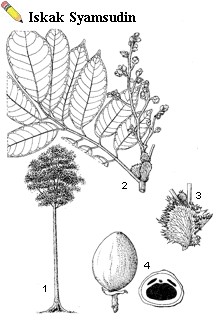Record Number
4020
PROSEA Handbook Number
5(2): Timber trees; Minor commercial timbers
Taxon
Canarium indicum L.
This article should be read together with the article on the genus: Canarium in the Handbook volume indicated above in this database.
This article should be read together with the article on the genus: Canarium in the Handbook volume indicated above in this database.
Protologue
Amoen. Acad. 4: 143 (1759).
Synonyms
Canarium mehenbethene Gaertner (1791), Canarium zephyrinum Duchesne (1836), Canarium moluccanum Blume (1850), Canarium amboinense Hochr. (1904).
Vernacular Names
Indonesia: kenari ambon (Sundanese), kanari ternate (northern Sulawesi), kanari bagea (Moluccas). Papua New Guinea: red canarium (general), galip (Pidgin), lawele (New Britain).
Distribution
Sulawesi, the Moluccas, New Guinea, the New Hebrides, the Solomon Islands and the Santa Cruz Islands; often cultivated in Melanesia and sometimes elsewhere.
Uses
The wood is used as kedondong, especially for light construction, mouldings, interior finish, and as a firewood. The edible seeds are more important: they are highly esteemed, especially in Melanesia. An oil extracted from the seeds serves as a substitute for coconut oil.
Observations
A medium-sized to fairly large tree up to 40 m tall, bole usually short, branchless for up to 10(—26) m, up to 100 cm in diameter, with buttresses up to 1 m high, bark surface smooth to scaly and dippled, grey or brownish-grey to yellow-brown, inner bark laminated, reddish-brown to pinkish-brown, exuding a milky resin; stipules persistent, rarely inserted on the petiole, ovate to oblong, large and prominently dentate; leaves with 7—15 leaflets, leaflets with apex gradually to distinctly acuminate, margin entire, glabrous, with (8—)10—15(—20) pairs of secondary veins which are slightly sunken above and prominent below; inflorescence terminal, broadly paniculate; male flowers c. 10 mm long, female ones up to 15 mm long, stamens 6; fruit ovoid, circular to slightly triangular in cross-section, 35—60 mm 15—30 mm, glabrous. Two varieties have been distinguished. Var. platycerioideum Leenh. differs from var. indicum in having larger leaflets and larger fruits and is rare in Irian Jaya. Canarium indicum occurs naturally in primary and secondary rain forest, up to 500(—1850) m altitude. The density of the wood is 500—650 kg/m3 at 12% moisture content. See also the table on wood properties.
Image
 | Canarium indicum L. – 1, tree habit; 2, flowering twig; 3, stipules; 4, fruit with cross section. |
Selected Sources
[60]Bolza, E. & Kloot, N.H., 1966. The mechanical properties of 81 New Guinea timbers. Technological Paper No 41. Division of Forest Products, CSIRO, Melbourne. 39 pp.
[145]Eddowes, P.J., 1977. Commercial timbers of Papua New Guinea, their properties and uses. Forest Products Research Centre, Department of Primary Industry, Port Moresby. xiv + 195 pp.
[154]Evans, B., 1993. Canarium nuts – a new cash crop for the Solomon Islands. ITTO Tropical Forest Update 3(2): 7, 19.
[162]Flora Malesiana (various editors), 1950–. Kluwer Academic Publishers, Dordrecht, Boston, London.
[330]Kraemer, J.H., 1951. Trees of the western Pacific region. Tri-State Offset Company, Cincinnatti. 436 pp.
[342]Lam, H.J., 1932. The Burseraceae of the Malay Archipelago and Peninsula, with annotations concerning extra-Malayan species, especially of Dacryodes, Santiria and Canarium. Contributions a l'Ttude de la flore des Indes NTerlandaises XXII. Bulletin du Jardin Botanique de Buitenzorg, STrie III, 12: 281–561.
[366]Leenhouts, P.W., 1959. Revision of the Burseraceae of the Malaysian area in a wider sense Xa. Canarium Stickm. Blumea 9: 275–647.
[673]Verheij, E.W.M. & Coronel, R.E. (Editors), 1991. Plant resources of South-East Asia No 2. Edible fruits and nuts. Pudoc, Wageningen. 446 pp.
[145]Eddowes, P.J., 1977. Commercial timbers of Papua New Guinea, their properties and uses. Forest Products Research Centre, Department of Primary Industry, Port Moresby. xiv + 195 pp.
[154]Evans, B., 1993. Canarium nuts – a new cash crop for the Solomon Islands. ITTO Tropical Forest Update 3(2): 7, 19.
[162]Flora Malesiana (various editors), 1950–. Kluwer Academic Publishers, Dordrecht, Boston, London.
[330]Kraemer, J.H., 1951. Trees of the western Pacific region. Tri-State Offset Company, Cincinnatti. 436 pp.
[342]Lam, H.J., 1932. The Burseraceae of the Malay Archipelago and Peninsula, with annotations concerning extra-Malayan species, especially of Dacryodes, Santiria and Canarium. Contributions a l'Ttude de la flore des Indes NTerlandaises XXII. Bulletin du Jardin Botanique de Buitenzorg, STrie III, 12: 281–561.
[366]Leenhouts, P.W., 1959. Revision of the Burseraceae of the Malaysian area in a wider sense Xa. Canarium Stickm. Blumea 9: 275–647.
[673]Verheij, E.W.M. & Coronel, R.E. (Editors), 1991. Plant resources of South-East Asia No 2. Edible fruits and nuts. Pudoc, Wageningen. 446 pp.
Author(s)
K.M. Kochummen
Correct Citation of this Article
Kochummen, K.M., 1995. Canarium indicum L.. In: Lemmens, R.H.M.J., Soerianegara, I. and Wong, W.C. (Editors): Plant Resources of South-East Asia No 5(2): Timber trees; Minor commercial timbers. PROSEA Foundation, Bogor, Indonesia. Database record: prota4u.org/prosea

All texts are licensed under a Creative Commons Attribution-Noncommercial-Share Alike 3.0 Netherlands License
This license does not include the illustrations (Maps,drawings,pictures); these remain all under copyright.